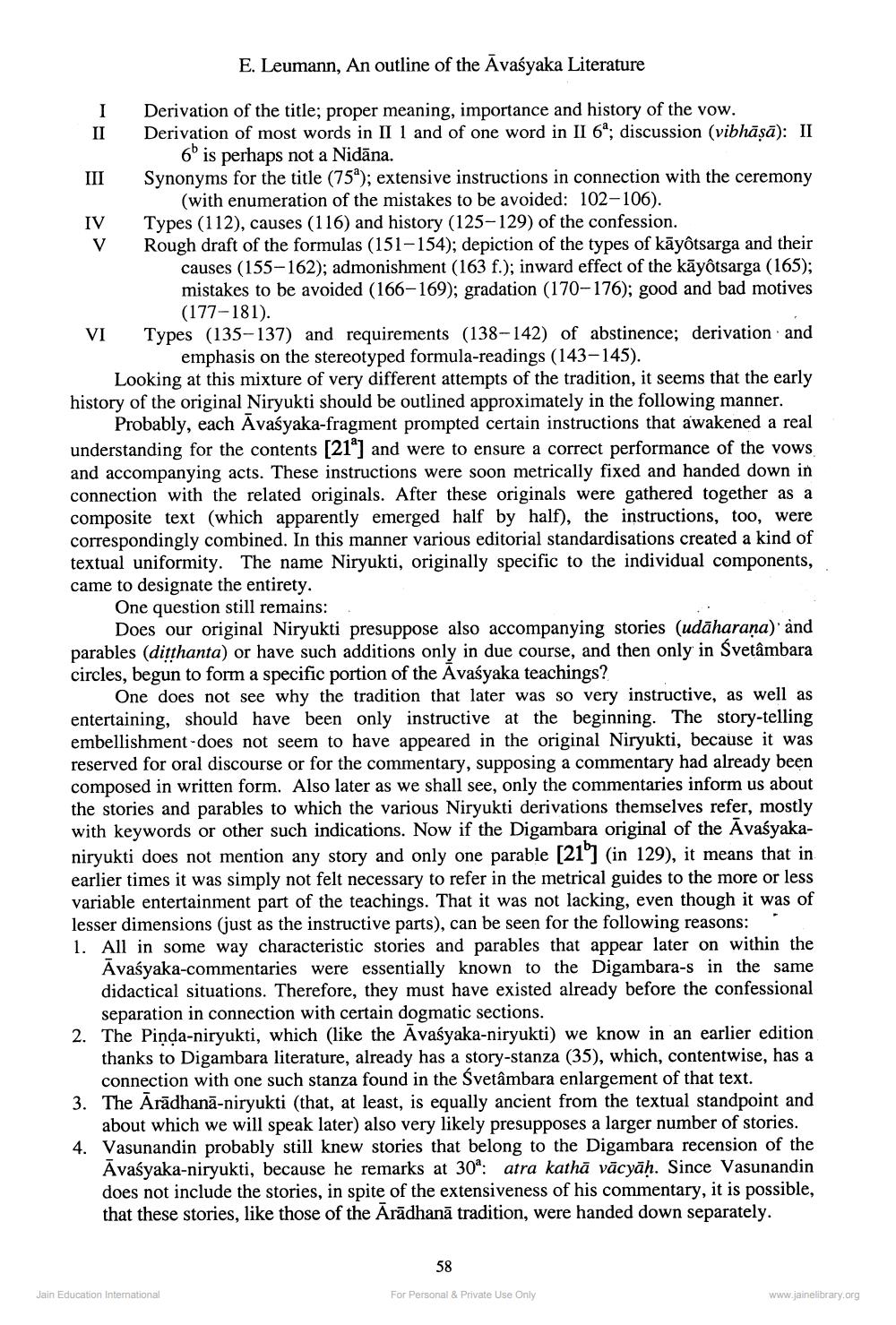________________
E. Leumann, An outline of the Avaśyaka Literature
III
Derivation of the title; proper meaning, importance and history of the vow. Derivation of most words in II 1 and of one word in II 6"; discussion (vibhāṣā): II
6 is perhaps not a Nidāna. Synonyms for the title (754); extensive instructions in connection with the ceremony
(with enumeration of the mistakes to be avoided: 102-106). IV Types (112), causes (116) and history (125-129) of the confession. V Rough draft of the formulas (151-154); depiction of the types of kāyôtsarga and their
causes (155-162); admonishment (163 f.); inward effect of the kāyôtsarga (165); mistakes to be avoided (166-169); gradation (170-176); good and bad motives
(177-181). VI Types (135-137) and requirements (138-142) of abstinence; derivation and
emphasis on the stereotyped formula-readings (143-145). Looking at this mixture of very different attempts of the tradition, it seems that the early history of the original Niryukti should be outlined approximately in the following manner.
Probably, each Āvaśyaka-fragment prompted certain instructions that awakened a real understanding for the contents [219] and were to ensure a correct performance of the vows and accompanying acts. These instructions were soon metrically fixed and handed down in connection with the related originals. After these originals were gathered together as a composite text (which apparently emerged half by half), the instructions, too, were correspondingly combined. In this manner various editorial standardisations created a kind of textual uniformity. The name Niryukti, originally specific to the individual components, came to designate the entirety.
One question still remains:
Does our original Niryukti presuppose also accompanying stories (udāharana) and parables (ditthanta) or have such additions only in due course, and then only in Svetâmbara circles, begun to form a specific portion of the Āvaśyaka teachings?
One does not see why the tradition that later was so very instructive, as well as entertaining, should have been only instructive at the beginning. The story-telling embellishment-does not seem to have appeared in the original Niryukti, because it was reserved for oral discourse or for the commentary, supposing a commentary had already been composed in written form. Also later as we shall see, only the commentaries inform us about the stories and parables to which the various Niryukti derivations themselves refer, mostly with keywords or other such indications. Now if the Digambara original of the Āvaśyakaniryukti does not mention any story and only one parable [21'] (in 129), it means that in earlier times it was simply not felt necessary to refer in the metrical guides to the more or less variable entertainment part of the teachings. That it was not lacking, even though it was of lesser dimensions (just as the instructive parts), can be seen for the following reasons: 1. All in some way characteristic stories and parables that appear later on within the
Avaśyaka-commentaries were essentially known to the Digambara-s in the same didactical situations. Therefore, they must have existed already before the confessional
separation in connection with certain dogmatic sections. 2. The Pinda-niryukti, which (like the Avaśyaka-niryukti) we know in an earlier edition
thanks to Digambara literature, already has a story-stanza (35), which, contentwise, has a
connection with one such stanza found in the Svetâmbara enlargement of that text. 3. The Ārādhanā-niryukti (that, at least, is equally ancient from the textual standpoint and
about which we will speak later) also very likely presupposes a larger number of stories. Vasunandin probably still knew stories that belong to the Digambara recension of the Āvaśyaka-niryukti, because he remarks at 30°: atra kathā vācyāḥ. Since Vasunandin does not include the stories, in spite of the extensiveness of his commentary, it is possible, that these stories, like those of the Arādhanā tradition, were handed down separately.
58
Jain Education International
For Personal & Private Use Only
www.jainelibrary.org




